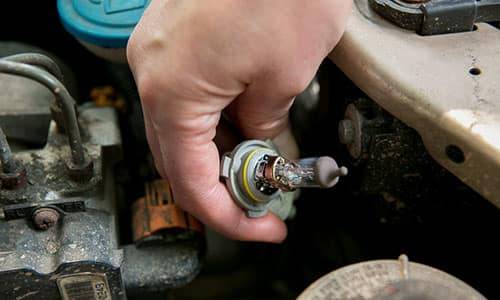How Long Should a Car's Light Bulbs Last?


CARS.COM — You depend on your car’s headlights to light the way in the dark and during inclement weather. In addition to allowing you to see, headlights ensure that others are able to see your car coming toward them. Like any light bulb, though, headlight bulbs can and do burn out. Whether you have halogen, xenon, LEDs, or any other type of bulb, it will not last forever. While it is obvious that you need to change a headlight bulb that burns out, you could save yourself a lot of hassle — and a potential ticket — by changing your headlight bulbs before they stop working. How do you know when to change your car’s headlights? Read on to find out.
Related: How Long Does a Car Battery in a New Car Last?
It stands to reason that the more often you use the various lights on your vehicle, the sooner you will have to replace the light bulbs. If you always drive with your headlights on, for example, you can expect the headlight bulbs to burn out sooner than if you only turn them on occasionally when driving at night. If you do not drive or use headlights frequently, they could last several years before you need a replacement.
Halogen Versus Xenon Versus LED
The type of bulb also is a factor. There are several different brands and styles on the market, but most can be divided into three types: halogen and xenon lights and LEDs. Generally speaking, halogen needs to to be replaced most frequently while LEDs last the longest. Each type has its own benefits and drawbacks, though.
Halogen headlights, for example, aren’t supposed to last as long as xenon high-intensity-discharge lights, though the latter are far more expensive. Halogen lights are the most popular type of headlight on the market even though they need be replaced the soonest. They are inexpensive to manufacturer, and they are the most affordable headlight option. Halogen bulbs contain halogen gas a a filament made of tungsten. When you turn your headlights on and electricity reaches the filament, the halogen gas heats up, causing the tungsten to glow. Halogen bulbs produce warm, yellowish light. While they can be quite bright, halogen bulbs do not produce the white light you may see coming from the headlights of other vehicles on the road. While they are the least expensive replacement bulb option, the need to frequently replace halogen lights may eat up your savings.
If you are looking for bright, white light and a longer lifespan, you may want to opt for xenon. Xenon lights are becoming increasingly common, and they produce white light that really illuminates the road ahead. These headlights are more expensive, but they last significantly longer than halogen headlights before you need to remove and replace them. The one downside is that xenon bulbs take a few moments to reach their full brightness when starting your car and turning on your headlights.
LEDs are said to last longer than both halogen and xenon (and use less energy) but, depending on the type and number required, are more expensive than either halogen or high-intensity-discharge. LEDs for headlights are a recent development designed to replace halogen and xenon headlights. They work differently than halogen and xenon headlights, so they aren’t very common — yet. LEDs work by generating photons using negative electrons. This process happens at a rate of thousands of times per second. This allows LEDs to provide strong, continuous light. LEDs are extremely efficient and last much longer than halogen and Xenon. Most often found on luxury vehicles, they are as stylish as they are efficient, and they are gaining traction in the high-end automotive world. LEDs are being used in various ways; some vehicles use LEDs for daytime running lights because they last a long time and have a stylish appearance.
Other Factors That Affect Headlight Lifespan
Sylvania, a major manufacturer of bulbs for automotive applications, says that the life of any bulb also depends on the amount of voltage a vehicle operates on. Some manufacturers have bumped up the voltage to handle all of the additional electrical loads on modern vehicles. The higher voltage, consequently, can shorten a bulb’s life. Frequently driving over rough, bumpy roads also can shorten halogen bulb life by damaging the filaments. If you drive on rough roads frequently, you may find that your headlights require replacement more often.
Though you may not notice, as headlights age, they don’t generate as much light as when they were new. That means your headlights may still work after five or six years, but they may not be as bright or light as much of the road as they used to. If you have to replace any bulb (or decide to before they burn out), check your owner’s manual to see what bulb is called for. If you’re a do-it-yourselfer, you should save money by replacing bulbs yourself. Information should be in your owner’s manual on this. Some headlight bulbs are extremely difficult to get at, and you may have to remove a battery or reach the bulb through a wheel well, so check this out as well before you decide to do it yourself. You might be able to find helpful tips online from others who have done it. Remember that your car has separate light bulbs for your high and low beams.
When you shop for headlight bulbs, you will probably discover that several are available for your car at different prices based on claims of brighter, whiter, longer, etc. Read the fine print. Sylvania says its Silver Star bulbs are 35 percent to 50 percent brighter than standard halogens but “may have a shorter life span.” The company says the average life of Silver Star bulbs is “approximately one year.” Always look for a high-quality light bulb that provides adequate light and illumination for safe driving.
Once your bulbs are changed, it’s time to ensure they’re aligned. How do you do that? Check out the video below.
Cars.com’s Editorial department is your source for automotive news and reviews. In line with Cars.com’s long-standing ethics policy, editors and reviewers don’t accept gifts or free trips from automakers. The Editorial department is independent of Cars.com’s advertising, sales and sponsored content departments.

Contributor Rick Popely has covered the auto industry for decades and hosts a weekly online radio show on TalkZone.com.
Featured stories




